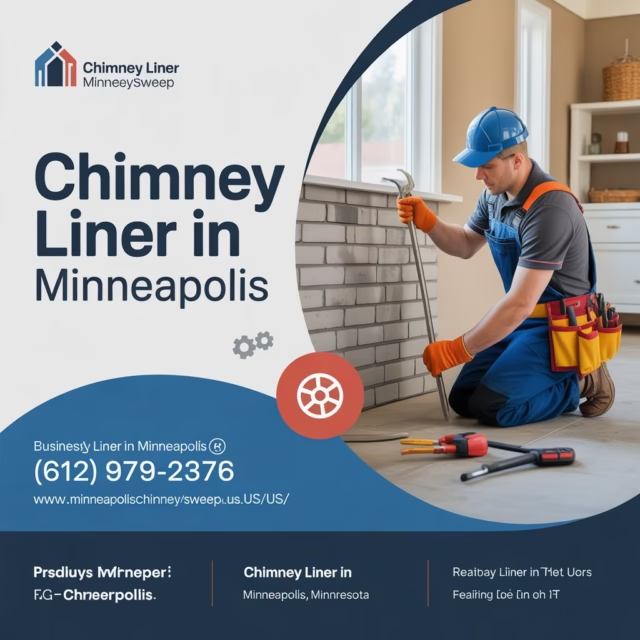Chimney liners are instrumental in ensuring the safety and performance of residential heating equipment. In cold climates such as Minneapolis, where chimneys are heavily utilized throughout the cold winter season, problems with chimney liners occur more often and are more dangerous. Early detection of these issues prevents damage to the structure, minimizes fire danger, and maximizes performance in your stove or fireplace.
This article discusses the most frequent difficulties homeowners experience with Chimney Liner Minneapolis.
Why It Matters
Chimney liners act as the interface between chimney walls and the hot exhaust gases of fires or heating appliances. A compromised or deteriorated liner can permit heat, sparks, and burning gases to pass through the masonry and ignite adjacent structural elements. In addition, unlined or defective chimneys lower appliance efficiency and add to creosote buildup—a highly combustible byproduct of wood combustion.
Steps to Identify and Diagnose
To promote safety and efficiency, it is strongly suggested that an annual inspection be done by a certified chimney technician. Nevertheless, homeowners and property managers can do the following:
Step 1: Visual Inspection – Use a flashlight or inspection camera to look for visible damage like cracks or loose tiles.
Step 2: Smoke Test – Professional services can perform smoke or pressure tests to test for liner leaks.
Step 3: Creosote Level Check – Excessive creosote at the end of a season shows ineffective liner performance or inadequate airflow.
Step 4: Chimney Performance – Dull draft, leakage of smoke, or stench within the home can be an indication of liner failure.
Chimney Liner Efficiency and System Optimization
Chimney systems today are dependent to a great extent upon Chimney Liner Efficiency to ensure safe and cost-effective functioning. A poorly efficient liner creates a constricted airflow, permitting combustion gases to cool and condense too early, thereby allowing excessive buildup of creosote and moisture.
Safety Considerations
Safety is the priority when it comes to chimney liners. A damaged liner raises the risk of house fires, carbon monoxide seepage, and structural deterioration. The Minneapolis Fire Department has reported several instances of fire cases every winter due to faulty chimneys, and most of them are avoidable with the right kind of maintenance. Safety precautions are:
- Placing a carbon monoxide alarm close to fireplaces or heating equipment.
- Shunning DIY work—liner installations or repairs should be left to certified technicians only.
- Having annual inspections, particularly prior to heating season.
- Employing only approved fuel or wood types in order to reduce residue and acid formation within liners.
Cost Breakdown
| Service Type | Estimated Cost (USD) | Description |
| Chimney Liner Inspection | $100 – $250 | Basic camera and visual inspections |
| Creosote Cleaning & Removal | $150 – $300 | Extended sweep in removal of flammable creosote deposits |
| Stainless Steel Liner Installation | $1,200 – $3,500 | Gas, oil, or wood-burning appliance compatible |
| Cast-in-Place Liner Installation | $2,000 – $5,000+ | Reinforced mortar lining for deteriorated masonry chimneys |
Disclaimer: Prices may fluctuate due to varying chimney heights, materials, difficulty of access, and Minneapolis local labor costs. Obtain detailed quotes from qualified service technicians.
FAQs
Q: How long does a chimney liner last in Minneapolis?
A: Liners made of clay tile will last 50 years with good maintenance, but harsh weather can cut this short. Stainless steel liners are frequently covered by a lifetime guarantee.
Q: Is my fireplace safe to use if the liner is cracked?
A: No. A cracked liner is a severe fire and gas hazard. Always fix or replace before resuming use.
Q: Do I need a liner in Minneapolis by law?
A: Yes. Safety and efficiency demand a working liner by building codes. Unlined chimneys are insurance risks and code violations.
Q: What’s the best type of liner for cold climates such as Minneapolis?
A: Insulated stainless steel liners work best in cold climates because they’re durable and condensation resistant.
Key Characteristics of a Well-Functioning Chimney Liner
- Tight and crack-free surface
- Ideally sized to the heating equipment
- Reliable and consistent draft
- Resistant to acid and moisture corrosion
- Good insulation from cold climate impacts
- Low creosote deposit formation
- Low maintenance with long life
If your chimney liner checks all these boxes, you’re probably having safe and efficient operation. Shortcomings in any of these areas call for immediate inspection and remedial action.
Professional Quote
“A properly installed and well-maintained chimney liner is the home’s first defense against house fires and exposure to flue gases. Particularly in cold climates like Minneapolis, residents should treat liner maintenance as an indispensable safety protocol,” according to James Alder, Twin City Fireplace & Stone’s Certified Chimney Specialist.
Conclusion
Chimney liner problems are not insignificant annoyances; they pose significant risks to home safety, appliance life, and fuel efficiency. In a city like Minneapolis, where heating equipment is subject to severe stress, issues like cracking, erosion, corrosion, and creosote deposits are a common occurrence.
Don’t underemphasize the vital importance of your Chimney Liner Minneapolis—shield your home, health, and investment with the correct strategy.
Read More: Chimney Sweep







